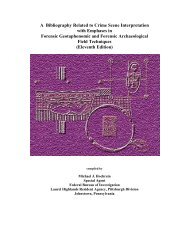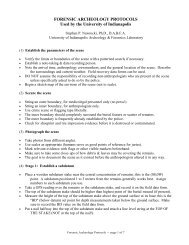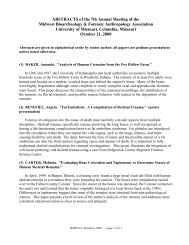Christopher W. Schmidt - University of Indianapolis Archeology ...
Christopher W. Schmidt - University of Indianapolis Archeology ...
Christopher W. Schmidt - University of Indianapolis Archeology ...
You also want an ePaper? Increase the reach of your titles
YUMPU automatically turns print PDFs into web optimized ePapers that Google loves.
effects <strong>of</strong> sex, age, and the sensitivity <strong>of</strong> ordinal regression, some <strong>of</strong> these traits may be less<br />
useful than others in determining ancestry in unknown cases. Ramus inversion, gonial inversion,<br />
muscle attachment sites, chin shape, number <strong>of</strong> mental foramina, and position <strong>of</strong> the mental<br />
foramen are the most effective traits to use when determining ancestry. However, caution must<br />
be taken because all <strong>of</strong> them except the number <strong>of</strong> mental foramen are significantly affected by<br />
sex. The number <strong>of</strong> mental foramina may be the most reliable trait because it is statistically and<br />
practically significant and it is not affected by sex, age, or the interaction between sex and<br />
ancestry. However, multiple foramina are very rare in all populations studied.<br />
European individuals were found to most likely posses little to no ramus inversion, no<br />
gonial eversion (straight gonia), gracile muscle attachment sites, a round or square chin, one<br />
mental foramen, and a more anteriorly placed mental foramen. Individuals <strong>of</strong> African descent<br />
were more likely to display moderate to extreme ramus inversion, gonial inversion, a round chin,<br />
and multiple mental foramina.<br />
This study is the first multivariate study conducted on discrete mandibular traits used for<br />
the determination <strong>of</strong> ancestry. Employing ordinal regression on a large sample <strong>of</strong> identified<br />
individuals, this study determines whether sex and age affect the incidence <strong>of</strong> each trait<br />
independently <strong>of</strong> ancestry. Additionally individuals from two separate continents are examined;<br />
therefore, the findings are applicable for worldwide use. While ancestry determination from the<br />
cranium has been established as reliable in the literature, a suite <strong>of</strong> characteristics derived from<br />
multiple bones is preferred. The inclusion <strong>of</strong> mandibular traits builds on previous non-metric<br />
studies and helps to increase the reliability <strong>of</strong> ancestral determination from the skeleton.<br />
v








